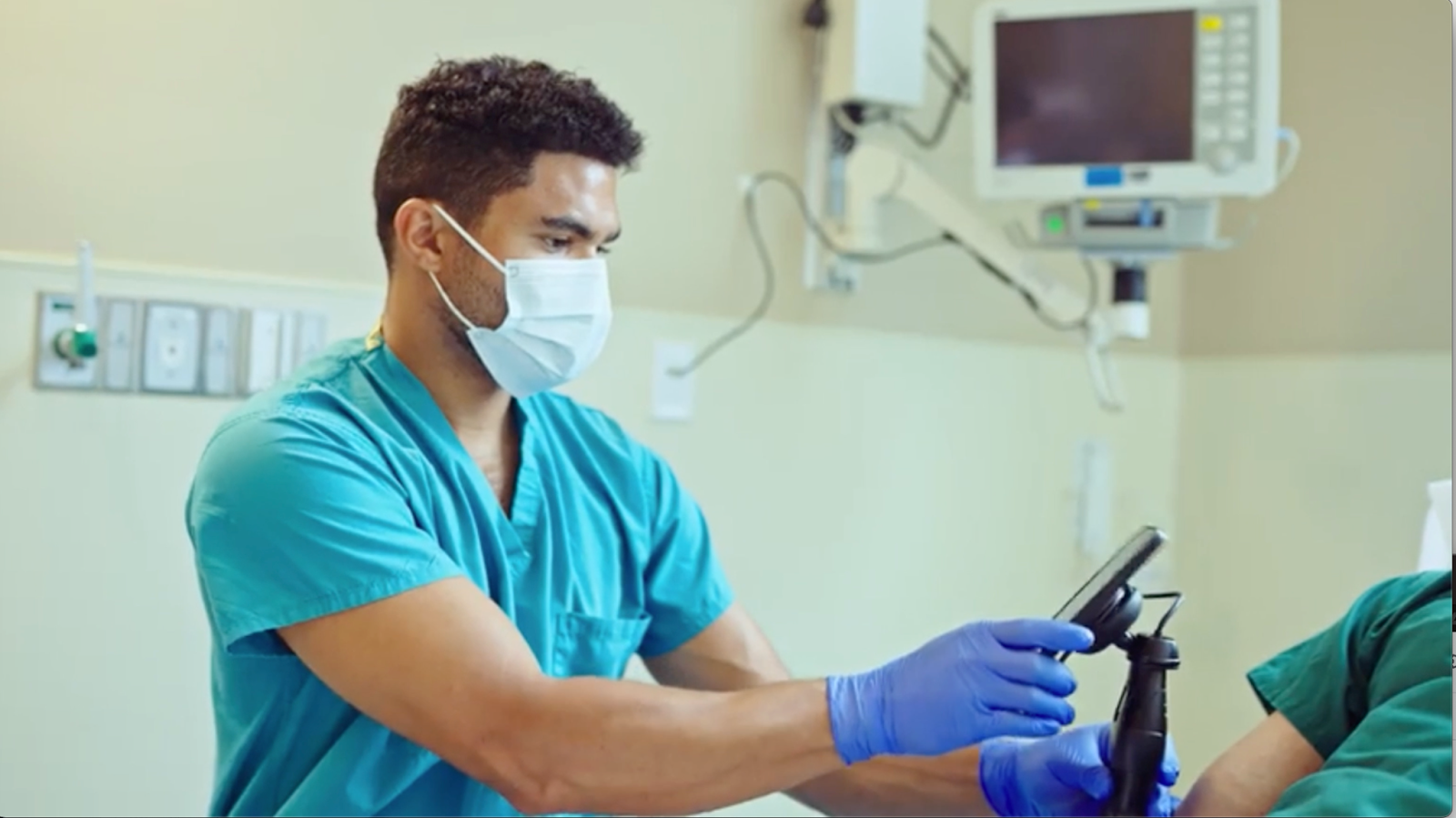Innovator Spotlight: Dr. Justin Moore, Co-Founder of OcuLine
By Madeline Grade, MD MSc
As is fitting for an emergency medicine innovation story, OcuLine began on a night shift during the pandemic. Dr. Justin Moore, then a second-year resident, was testing out a Butterfly handheld ultrasound device with Dr. Arun Nagdev, the Director of Emergency Ultrasound at Highland Hospital. As he tried to incorporate the device into his care of patients, he quickly realized its limited utility for procedures, namely finding a place to prop the phone screen while attempting an ultrasound-guided IV or nerve block. He had recently used the McGRATH handheld video laryngoscope and wondered, “Why don’t we have this for ultrasound? Why not have a probe with a screen attached?” to which Nagdev replied, “That is a great idea.” This immediate buy-in was just the push he needed to explore further.
Moore has always been a hands-on person. He grew up on a farm and was often tinkering and building. He had no formal training in engineering or design, and certainly no prior experience in building a company. So, when this opportunity arose, he decided to teach himself. The first several months of developing OcuLine were, in Moore’s words, “an incredibly fun crash course in designing something that’s actually going to be adopted, used, and functional.” Once he started, he was surprised to realize that degrees and certifications weren’t prerequisites for success – all you truly need is perseverance.
The iterative process began in earnest. Moore tried everything: taping the phone to the Butterfly, building plastic devices that could attach and detach, affixing the screen directly to his arm, and at one point even considered using Google glasses. He taught himself how to do basic computer-aided design (CAD), bought a 3D printer off Amazon for $200, and started watching videos and making prototypes. He recalls, “it took hours because I had no idea what I was doing and was learning so much every day. It was a ton of fun, using calipers to measure the Butterfly, designing and printing a prototype, testing it out – though of course it would never work. We probably went through 30 iterations of different geometries and ways to secure it, and at times wondered if we were even on the right track.”
This was by no means an easy process, but Moore found that not only was designing a device and learning these new skills fun, it in fact provided much-needed balance to his clinical workload in residency. He recalls being on trauma overnights, doing CAD in the charting room in slower moments, or coming home from an ED shift and unwinding by printing his next prototype. He found himself being creative in a way he never knew he could be, and he gained a huge personal insight that he could find unique fulfillment and balance outside of patient care.
Eventually, Moore and Nagdev were able to create a functional prototype that secured the phone screen to the probe, but the work didn’t stop there. They tested it repeatedly on-shift, gaining additional insights and making small improvements (e.g. adding a hinge to rotate the screen for nerve blocks, or making the viewing angle adjustable for variable patient positioning) until the device was ready for the next stage. This prompted even more areas of learning: what is a patent lawyer? What is a patent, really? As each next step in the development process arose, they learned about industrial designers, mechanical engineers, manufacturers, the process of incorporating, the process of pitching and funding. Moore emphasizes how grateful he has been for his co-founder along the way. Nagdev, who is an expert in the field of emergency ultrasound (as well as the past Chair of the ACEP Ultrasound Section), has been an invaluable sounding board for ideas and questions during each step of the process.
OcuLine’s flagship product is now available commercially and is already being implemented globally across a wide variety of specialties (emergency medicine, anesthesia, family medicine), roles (physicians, advanced practice providers, nurses, EMTs), and settings (rural practice, flight medicine, home health). Moore knows there are surely more challenges ahead, but he’s incredibly excited to continue learning.
Dr. Justin Moore demonstrating OcuLine’s adjustability and ease of use (Credit: Moore)
The most important piece of advice Moore has for aspiring innovators is to have perseverance, and if at all possible, to frame the innovation journey as an educational investment. Throughout this process, which required countless hours of self-directed learning and significant personal financial input up-front, he viewed it as an investment in himself and his personal toolkit – an ad-hoc degree in entrepreneurship. He thinks that this perspective helped him through challenges such as the back-and-forth of fundraising, because he felt that even if the product “failed” he would still have gained a foundational educational experience.
Currently, Moore is complementing his hands-on education with more formalized design methods as a Stanford Biodesign Innovation Fellow. According to Moore, “They have this well oiled machine, a tried and true process of over 20 years. You’re surrounded by people who talk the talk and walk the walk. Going into Biodesign after creating OcuLine has made me a little more self conscious, because I’m sure there’s something that would have been changed by going through this process. But the silver lining is that I now have real context with which to apply this learning, so I’m getting a lot more out of it than perhaps I otherwise would have.” Moore has also come to realize that there are so many different ways to approach a given problem, and accordingly his colleagues stem from incredibly diverse backgrounds. “There is no one set of perfect skills that allow someone to succeed in innovation. Understanding this opens it up for everyone.”




